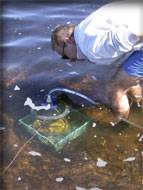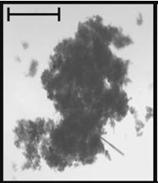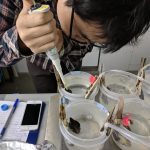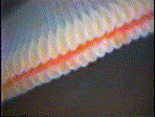J. Evan Ward
(Ph.D., University of Delaware) Professor and Head of Marine Sciences
 Research in my laboratory is directed towards an understanding of the dynamic interactions between marine animals and their environment. In particular, my work focuses on the endogenous and exogenous factors that mediate the behavior and physiology of benthic, particle-feeding invertebrates. My students and I take an integrative approach in our research program by studying processes ranging from the organism to ecosystem level. Much of this research focuses on commercially important bivalves such as clams, oysters, mussels and scallops. These animals are key components of most coastal ecosystems, provide vital ecosystem services, and are an important link between the oceans and human health. For more information about my research laboratory, please visit my web page.
Research in my laboratory is directed towards an understanding of the dynamic interactions between marine animals and their environment. In particular, my work focuses on the endogenous and exogenous factors that mediate the behavior and physiology of benthic, particle-feeding invertebrates. My students and I take an integrative approach in our research program by studying processes ranging from the organism to ecosystem level. Much of this research focuses on commercially important bivalves such as clams, oysters, mussels and scallops. These animals are key components of most coastal ecosystems, provide vital ecosystem services, and are an important link between the oceans and human health. For more information about my research laboratory, please visit my web page.
-
- Interactions Between Marine Aggregates and Benthic Suspension Feeders: Living and non-living particulate matter is ubiquitous in aquatic systems. Through physical, chemical and biological interactions, this material aggregates into larger particle masses (marine snow, flocs). Aggregation of particles has been recognized as an important mechanism for the transport of carbon, nutrients, and other materials to the benthos. Our work on the interaction of aggregates and suspension feeders can be divided into two areas of focus.
- Aggregates, TEP and benthic pelagic coupling – The traditional concept of benthic-pelagic coupling by suspension feeders involves the removal of phytoplankton and other particles from the water column, deposition of feces and pseudofeces to the bottom, and conversion of food material for animal production. We have described another possible mechanism by which coupling could occur. This mechanism involves
 production of transparent exopolymer particles (TEP) by suspension feeders, and enhanced aggregation and deposition of material to benthic populations. This process may represent an important but under-studied process that impacts water column processes and the fate of organic matter in near-shore waters.
production of transparent exopolymer particles (TEP) by suspension feeders, and enhanced aggregation and deposition of material to benthic populations. This process may represent an important but under-studied process that impacts water column processes and the fate of organic matter in near-shore waters. - The aggregate pathway and enhanced uptake of nanomaterials (an Oceans and Human Health Linkage) – Manufactured nanoparticles and nanotubes are at the forefront of nanotechnology and are being used in a variety of applications including cosmetics, electronics, drug delivery, manufacturing technologies, molecular biology, and paints. The way in which nanoparticles are taken up by aquatic organisms, however, has been little studied. In this project, we are considering how feeding limitations of several bivalve species affect their uptake of nanoparticles, and determining how the form of delivery (freely suspended or incorporated in aggregates) mediates bioavailability, retention, and thus internal exposure. This work is being conducted in collaboration with Rob Mason (Department of Marine Sciences).
- Aggregates, TEP and benthic pelagic coupling – The traditional concept of benthic-pelagic coupling by suspension feeders involves the removal of phytoplankton and other particles from the water column, deposition of feces and pseudofeces to the bottom, and conversion of food material for animal production. We have described another possible mechanism by which coupling could occur. This mechanism involves
- Feeding Behavior and Physiology of Suspension Feeders: In this line of research, we are addressing fundamental questions regarding suspension feeding mechanisms. We are investigating the plasticity of particle capture in two groups of invertebrate
 suspension-feeders (bivalves, tunicates) to determine if particle capture responds to changes in the number and types of planktonic cells available (i.e., plasticity), or if capture is a consequence of the physicochemical properties of the cells (e.g., size, shape, surface charge, wettability). The combined application of in situ and laboratory studies allow us to examine the full range of planktonic cells that suspension feeders capture, and address fundamental questions regarding physiological control of particle capture (or lack thereof) under different particle spectra (i.e., changing food supplies). Results of the study will provide insight into the factors influencing mechanisms of particle capture, and strengthen existing models regarding interspecific competition and impacts of suspension feeders on microbial community structure of the seston. This work is being conducted in collaboration with Israeli and Canadian scientists.
suspension-feeders (bivalves, tunicates) to determine if particle capture responds to changes in the number and types of planktonic cells available (i.e., plasticity), or if capture is a consequence of the physicochemical properties of the cells (e.g., size, shape, surface charge, wettability). The combined application of in situ and laboratory studies allow us to examine the full range of planktonic cells that suspension feeders capture, and address fundamental questions regarding physiological control of particle capture (or lack thereof) under different particle spectra (i.e., changing food supplies). Results of the study will provide insight into the factors influencing mechanisms of particle capture, and strengthen existing models regarding interspecific competition and impacts of suspension feeders on microbial community structure of the seston. This work is being conducted in collaboration with Israeli and Canadian scientists. - Ingestion and Egestion of Microplastics by Bivalves: Plastics (synthetic polymers) are one of the most common and persistent pollutants in marine waters worldwide. Weathering of macroplastic materials results in the release of microplastics, the environmental damage of which is largely unknown. In this research, field studies are quantifying the types and qu
 antities of plastic particles found in bivalves growing in natural populations and aquaculture farms. Under controlled laboratory conditions, bivalves are being exposed to several types of microplastics with different physicochemical characteristics (i.e., size, shape, aspect ratio, surface charge, surface wettability), and the most frequently ingested and most frequently rejected types are being determined. With these data we are developing a model that can predict, based on the physicochemical properties of the plastic particles, which types are likely taken up by the bivalves. This research is being conducted in collaboration with Sandra Shumway (Department of Marine Sciences), and Kevin Brown (Oregon State University).
antities of plastic particles found in bivalves growing in natural populations and aquaculture farms. Under controlled laboratory conditions, bivalves are being exposed to several types of microplastics with different physicochemical characteristics (i.e., size, shape, aspect ratio, surface charge, surface wettability), and the most frequently ingested and most frequently rejected types are being determined. With these data we are developing a model that can predict, based on the physicochemical properties of the plastic particles, which types are likely taken up by the bivalves. This research is being conducted in collaboration with Sandra Shumway (Department of Marine Sciences), and Kevin Brown (Oregon State University). - Interactions between Benthic Suspension Feeders and their Microbial Communities: Prokaryotic organisms are ubiquitous and essential to all habitats on Earth. Within the marine environment, bacteria sustain the base of food webs, drive a manifold of biogeochemical processes and through symbioses, influence the evolution of multicellular life. Although bivalves are important members of coastal ecosystems and have commercial value, their microbiomes remain largely unexplored. In this project, we are investigating the genetic and functional diversity of the bivalve-associated microbiome to understand its involvement in host physiological processes. We are interested in the role of gut and gill microbiota in bivalve toxicology, specifically involving anthropogenic pollutants like microplastics, nanoparticles, and pesticides. We utilize traditional bivalve husbandry and toxicological methods along with high-throughput sequencing and culture-based microbial techniques to conduct this research.
- Interactions Between Marine Aggregates and Benthic Suspension Feeders: Living and non-living particulate matter is ubiquitous in aquatic systems. Through physical, chemical and biological interactions, this material aggregates into larger particle masses (marine snow, flocs). Aggregation of particles has been recognized as an important mechanism for the transport of carbon, nutrients, and other materials to the benthos. Our work on the interaction of aggregates and suspension feeders can be divided into two areas of focus.
Research Projects
Mediation of biological filtration in marine suspension feeders: significance of intrinsic and extrinsic factors – National Science Foundation (US) and Bi-National Science Foundation (Israel)
Selective ingestion of microplastics by oysters: exposure assessment as a predictive tool for assessing the environmental risk to commercially important bivalves – NOAA, Marine Debris Program.
Oceanography Students
Hannah Collins – M.Sc. Student
Vena Haynes – Ph.D. Student
Tyler Griffin – Ph.D. Student
Kayla Mladinich – Ph.D. Student
Oceanography Alumni
John Doyle – Ph.D. 2014
Dane Frank – Ph.D. 2010
Kari Heinonen – M.Sc. 2004
Dustin Kach – M.Sc. 2009
Binglin Li – M.Sc. 2006
Maille Lyons – Ph.D. 2008
Michael McKee – M.Sc. 2002
Lisa Milke – M.Sc. 2001
Melissa Pierce – Ph.D. 2016
Maria Rosa – Ph.D. 2016
Research Staff
Publications (past 10 years)
-
-
- Ward, J.E., S. Zhao, B.A. Holohan, K.M. Mladinich, T.W. Griffin, J. Wozniak & S.E. Shumway, 2019. Selective ingestion and egestion of plastic particles by the blue mussel (Mytilus edulis) and eastern oyster (Crassostrea virginica): Implications for using bivalves as bioindicators of microplastic pollution. Env. Sci. & Tech. 53: 8776-8784.
- Ward, J.E., M. Rosa & S.E. Shumway, 2019. Capture, ingestion and egestion of microplastics by suspension-feeding bivalves: a 40-year history. Anthropocene Coasts 2: 39-49.
- Buckman, K.L., E.A Seelen, R.P. Mason, P. Balcom, V.F. Taylor, J.E. Ward and C.Y. Chen, 2019. Sediment organic carbon and temperature effects on methylmercury concentration: a mesocosm experiment. Sci. Total Environ. 666: 1316â1326.
- Zhao, S., J.E. Ward, M. Danley & T.J. Mincer, 2018. Field-based evidence for microplastic in marine aggregates and mussels: Implications for trophic transfer. Env. Sci. & Tech. 52: 11038â11048.
- Pierce, M.L. & J.E. Ward, 2018. Microbial ecology of the Bivalvia, with an emphasis on the family Ostreidae. J. Shellfish Res. 37: 793-806.
- Rosa, M., J.E. Ward & S.E. Shumway, 2018. Selective capture and ingestion of particles by suspension-feeding bivalve molluscs: A review. J. Shellfish Res. 37: 727-746.
- Jasperse, L., M.J. Levin, K. Tsantiris, R. Smolowitz, C. Perkins, J.E. Ward & S. De Guise, 2018. Comparative toxicity of Corexit® 9500, oil, and a Corexit®/oil mixture on the eastern oyster, Crassostrea virginica (Gmelin). Aq. Toxicol. 203: 10-18.
- Doyle, J.J., J.E. Ward & G.H. Wikfors, 2018. Acute exposure to TiO2 nanoparticles produces minimal apparent effects on oyster, Crassostrea virginica (Gmelin), hemocytes. Mar. Pollution Bull. 127: 512-523.
- Rosa, M., J.E. Ward, A. Frink & S.E. Shumway, 2017. Effects of particle-surface properties on particle capture by two species of suspension-feeding bivalve molluscs. Am. Malacol. Bull. 35:181-188.
- Haynes, V.N., J.E. Ward, B.J. Russell & A.G. Agrios, 2017. Photocatalytic effects of titanium dioxide nanoparticles on aquatic organisms â Current knowledge and suggestions for future research. Aquatic Toxic. 185: 138-148.
- Zhao, S.Y., M. Danley, J.E. Ward, D. Li & T.J. Mincer, 2017. An approach for extraction, characterization and quantitation of microplastic in natural marine snow using Raman microscopy. Anal. Meth. 9: 1470-1478.
- Rosa, M., J.E. Ward, B.A. Holohan, S.E. Shumway & G.H. Wikfors, 2017. Physicochemical surface properties of microalgae and their combined effects on particle selection by suspension-feeding bivalve molluscs. J. Exp. Mar. Biol. Ecol. 486: 59-68.
- Kramer, A.M., J.E. Ward, F.C. Dobbs, M.L. Pierce & J.M. Drake, 2016. The contribution of marine aggregate-associated bacteria to the accumulation of pathogenic bacteria in oysters: an agent-based model. Ecol. Evol. 6: 7397-7408.
- Pierce, M.L., J.E. Ward, B.A. Holohan, X. Zhao & R.E. Hicks, 2016. The influence of site and season on the gut and pallial fluid microbial communities of the eastern oyster, Crassostrea virginica (Gmelin): community-level physiological profiling and genetic structure. Hydrobiologia, 765: 97-113.
- Doyle, J.J., J.E. Ward & R. Mason, 2016. Exposure of bivalve shellfish to titania nanoparticles under an environmental-spill scenario: Encounter, ingestion, and egestion. J. Mar. Biol. Assoc., UK. 96: 137-149.
- Rosa, M., J.E. Ward, M. Ouvard, B.A. Holohan, E. Pales Espinosa, S.E. Shumway & B. Allam, 2015. Examining the physiological plasticity of particle capture by the blue mussel, Mytilus edulis (L.): confounding factors and potential artifacts with studies utilizing natural seston. J. Exp. Mar. Biol. Ecol. 473: 207â217.
- Doyle, J.J., J.E. Ward & R. Mason, 2015. An examination of the ingestion, bioaccumulation, and depuration of titanium dioxide nanoparticles by the blue mussel (Mytilus edulis) and the eastern oyster (Crassostrea virginica). Mar. Environ. Res., 110: 45-52.
- Ortiz, V., R.P. Mason & J.E. Ward, 2015. An examination of the factors influencing mercury and methylmercury particulate distributions, methylation and demethylation rates in laboratory-generated marine snow. Mar. Chem. 177: 753â762.
- Frank, D.M., L. Deaton, S.E. Shumway, B.A. Holohan & J.E. Ward, 2015. Modulation of pumping rate by two species of marine bivalve molluscs in response to neurotransmitters: comparison of in vitro and in vivo results. Comp. Biochem. Physiol., Part A. 185: 150â158.
- Doyle, J.J., V. Palumbo, B.D. Huey & J.E. Ward, 2014. Behavior of titanium dioxide nanoparticles in three aqueous media samples: Agglomeration and implications for benthic deposition. Water, Air, & Soil Pollution, 225: 2106.
- Shumway, S.E., J.E. Ward, E. Heupel, B.A. Holohan, J. Heupel, T. Heupel & D.K. Padilla, 2014. Observations of feeding in the common Atlantic slippersnail Crepidula fornicata L., with special reference to the “mucus net.” J. Shellfish Res. 33: 1â13.
- Pierce, M.L., J.E. Ward & F.C. Dobbs, 2014. False positives in Biolog EcoPlatesTM and MT2 MicroPlatesTM caused by calcium. J. Microbiolog. Meth. 97: 20â24.
- Rosa, M., J.E. Ward, S.E. Shumway, G.H. Wikfors, E. PalesâEspinosa & B. Allam, 2013. Effects of particle surface properties on feeding selectivity in the eastern oyster Crassostrea virginica and the blue mussel Mytilus edulis. J. Exp. Mar. Biol. Ecol. 446: 320-327.
- Wall, C.C., C.J. Gobler, B.J. Peterson & J.E. Ward, 2013. Contrasting growth patterns of suspensionâfeeding molluscs (Mercenaria mercenaria, Crassostrea virginica, Argopecten irradians, Crepidula fornicata) across a eutrophication gradient in the Peconic Estuary, NY, USA. Estuaries & Coasts, 36, 1274â1291.
- Allam, B., W.E. Carden, J.E. Ward, G. Ralph, S. Winnicki & E. Pales Espinosa, 2013. Early hostâpathogen interactions in marine bivalves: Evidence that the alveolate parasite Perkinsus marinus infects through the oyster mantle during rejection of pseudofeces. J. Invert. Path., 113: 26-34.
- Cranford, P.J., J.E. Ward & S. Shumway, 2011. Bivalve filter feeding: variability and limits of the aquaculture biofilter. In: S.E. Shumway (ed.), Shellfish Aquaculture and the Environment, John Wiley & Sons Publ., 81-124.
- Robbins, H.M., V.M. Bricelj & J.E. Ward, 2010. In vivo effects of brown tide on the feeding function of the gill of the northern quahog Mercenaria mercenaria (Bivalvia: Veneridae). Biol. Bull. 219: 61â71.
- Pales Espinosa, E., D. Hassan, J.E. Ward, S.E. Shumway & B. Allam, 2010. Role of epicellular molecules in the selection of particles by the blue mussel, Mytilus edulis. Biol. Bull., 219: 50-60.
- Lyons, M. M., J. E. Ward, H. Gaff, R. Hicks, J. Drake & F.C. Dobbs, 2010. Theory of island biogeography on a microscopic scale:Â Are organic aggregates islands for aquatic pathogens? Aquatic Microbial Ecology, 60: 1â13.
- Pales Espinosa, E., M. Perrigault, J.E. Ward, S.E. Shumway & B. Allam, 2010. Microalgal cell surface carbohydrates as recognition sites for particle sorting in suspensionâfeeding bivalves. Biol. Bull. 218: 75â86.
- Pales Espinosa, E., M. Perrigault, J.E. Ward, S.E. Shumway & B. Allam, 2009. Lectins associated with the feeding organs of the oyster Crassostrea virginica can mediate particle selection. Biol. Bull., 217: 130â141.
- Mafra, L.L. Jr., V.M. Bricelj & J.E. Ward, 2009. Mechanisms contributing to low domoic acid uptake by oysters feeding on Pseudoânitzschia cells. II. Selective rejection. Aquatic Biol., 6: 213â226.
- Meseck, S.L., J.H. Alix, G.H. Wikfors & J.E. Ward, 2009. Differences in the soluble, residual phosphate concentrations at which coastal phytoplankton species upâregulate alkalineâphosphatase expression, as measured by flowâcytometric detection of ELFâ97 fluorescence. Estuaries & Coasts, 32: 1195â1204.
- Ward, J.E. & D.J. Kach, 2009. Marine aggregates facilitate ingestion of nanoparticles by suspensionâfeeding bivalves. Mar. Env. Res., 68: 137â142.
- MacDonald, B.A. & J.E. Ward, 2009. Feeding activity of scallops and mussels measured simultaneously in the field: Repeated measures sampling and implications for modelling. J. Exp. Mar. Biol. Ecol. 371: 42â50.
-
                                    Â
Note: Research material is based upon work supported by the National Science Foundation, National Institutes of Health, and National Oceanographic & Atmospheric Administration. Any opinions, findings and conclusions, or recommendations expressed in this material are those of the author and do not necessarily reflect the views of the NSF, NIH or NOAA.

| evan.ward@uconn.edu | |
| Phone | 860-405-9073 |
| Fax | 860-405-9153 |
| Link | https://ward.lab.uconn.edu/ |